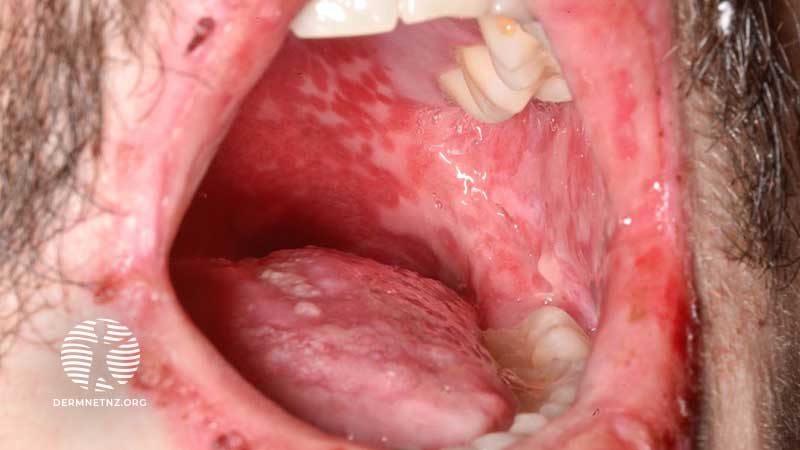Main menu
Common skin conditions

NEWS
Join DermNet PRO
Read more
Quick links
18-year-old with targetoid lesions and mucositis
Last reviewed: January 2024
Author: Dr Aliana Corlett, Wellington Hospital, New Zealand.
Reviewing dermatologist: Dr Ian Coulson (2024)
Edited by the DermNet content department.

Background
This 18-year-old male presented to ED with a 1 week history of widespread target shaped lesions on his trunk, legs, and arms as well as severe oral mucositis. The rash had initially started around his eyes, progressing to a widespread eruption of discrete lesions affecting his hands, trunk and limbs, with erosion of his oral and genital mucosa. He had very poor oral intake for 3 days prior to admission.
What are the differential diagnoses?
- Erythema multiforme — target lesions with or without mucosal erosion, often viral-induced
- Stevens-Johnson syndrome / toxic epidermal necrolysis (SJS/TEN)
- Mycoplasma pneumoniae-induced rash and mucositis
What additional history do you want?
- Has there been any history to suggest a recent cold sore or other viral illnesses?
- Have there been respiratory symptoms to suggest recent Mycoplasma infection?
- Has there been any drug exposure?
What is the most likely diagnosis?
Erythema multiforme is an immune-mediated condition generally characterised by target lesions which can blister centrally, and can also include erosions or bullae in the mucosae of the mouth, genitals, or conjunctivae. The target skin lesions may be pruritic and mucosal erosions can be very painful. The patient may experience fatigue, myalgias, and fevers
Viral infections such as herpes simplex virus (HSV) are often, although not always, involved in the development of this condition.
SJS/TEN tends to produce coalescing lesions affecting more than 10% of the body surface area and is usually drug induced.
Mycoplasma pneumonia-induced rash and mucositis has recently been distinguished from erythema multiforme; the skin lesions are less prominent and it carries a better prognosis than erythema multiforme triggered by other agents.
What treatment do you suggest?
Erythema multiforme is generally self-limiting and symptoms usually resolve in 4–6 weeks. Oral antihistamines or topical steroids may be used for itch if required. It may recur with subsequent attacks of herpes simplex if this is the trigger and if frequent suppressive antiviral therapy may be indicated.
In erythema multiforme major with severe mucosal erosion, support of oral intake (eg, lidocaine oral gel and nutritional supplements) may be necessary.
Prednisone is often used in practice to reduce the length of the illness and its severity, but its use is not strongly evidence-based.
See: Erythema multiforme.
